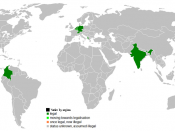As people in our nation experience longer life spans, the question of how long a life should be prolonged, especially under conditions when one is suffering from a life threatening illness, has grown into a major public policy debate. One side of the argument involves doctor-assisted suicide, or euthanasia.
Euthanasia is a topic that has received growing attention in Western industrialized nations in recent years. No longer is the debate over the legalization of doctor-assisted suicide and active euthanasia limited to the pages of ethics journals or the scholarly forums (Campbell 1992). One interesting aspect of euthanasia is that it is gaining support not only nationwide, but also internationally. Survey data and limited quantitative evidence indicate that euthanasia is becoming more acceptable and more openly resorted to than in the recent past (Logue 1991). In this paper, the changing attitudes towards euthanasia and the types of people who seem to favor and oppose euthanasia are examined.
No attempt will be made to separate the different types of euthanasia. Rachels (1977) has made a convincing case that the often-drawn distinction between "active" and "passive" euthanasia is a false dichotomy (Logue 1991). To keep things relevant, this paper defines euthanasia as the practice of inducing a painless death for reasons assumed to be merciful (Meucci 1988).
A 1985 report by Dr. Samuel Waller states that support for euthanasia has increased during the past 20 years, particularly in Australia, the Netherlands (where support rose from 30 to 70 percent between 1972 and 1984), and in Canada (where support rose from 45 to 65 percent between 1968 and 1984) (Meucci 1988). Many surveys in the United States have also shown growing support. Gallup polls showed that in 1947 only 37 percent favored aid-inìdying, but in 1986 66 percent were in favor (Logue 1991). The...


